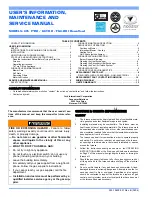
7
CAUTION
When a 0.75 USGPH or smaller nozzle is used, a 10 micron or
finer filter, must be installed on the oil supply line to the
furnace inside the building where the unit is located.
This is a requirement in order for the heat exchanger warranty
to remain in force.
Check your local codes for the installation of the oil tank and
accessories.
At the beginning of each heating season or once a year, check
the complete oil distribution system for leaks.
Ensure that the tank is full of clean oil. Use No.1 or No.2
Heating Oil (ASTM D396 U.S.) or in Canada, use No.1 or No.2
Furnace Oil.
A manual shut-off valve and an oil filter shall be installed in
sequence from tank to burner. Be sure that the oil line is clean
before connecting to the burner. The oil line should be
protected to eliminate any possible damage. Installations
where the oil tank is below the burner level must employ a two-
pipe fuel supply system with an appropriate fuel pump. A rise
of 2.4 m (8') and more requires a two stage pump and a rise
greater than 4.9 m (16') an auxiliary pump. Follow the pump
instructions to determine the size of pipe needed in relation to
the rise or to the horizontal distance.
2.9 DUCTING
WARNING
Poisonous carbon monoxide gas hazard.
DO NOT draw return air from inside a closet or utility
room. Return air MUST be sealed to the furnace casing.
Failure to properly seal ducts can result in death, bodily
injury and/or property damage.
The ducting must be designed and installed according to
approved methods, local and national codes as well as good
trade practices.
When ducting supplies air to a space other than where the
furnace is located, the return air must be sealed and also be
directed to the space other than where the furnace is located.
2.9.1 Air
filter
A properly sized air filter must be installed on the return air
side of the unit. Refer to the Technical Specifications, p.13, for
the correct dimensions. Also refer to Section 2.3 and the
instructions supplied with the filter.
2.10
SUPPLY AIR ADJUSTMENT (4 SPEED
MOTOR)
On units equipped with 4-speed blower motors, the supply air
must be adjusted based on heating/air conditioning output and
the static pressure of the duct system. For the desired air flow
refer to the following table as well as the air flow tables based
on static pressure in the Technical Specifications section of
this manual.
Table 1: Blower speed adjustments (heating mode, 4
speed motor)
HEATING
CAPACITY
(USGPH)
STATIC
PRESSURE
(W.C.)
RECOMMENDED
BLOWER SPEED
0.90
0.25” MED-LOW
0.90
0.50” MED-LOW
1.10
0.25” MED-HIGH
1.10
0.50” MED-HIGH
Table 2: Blower speed adjustments (A/C mode, 4 speed
motor)
A/C CAPACITY
(TONS)
RECOMMENDED
BLOWER SPEED
3.0
LOW
3.5
MED-LOW
4.0
MED-HIGH
5.0
HIGH
To effect the adjustment, the RED (for heating) and BLUE
(for cooling and heat pump) wires can be changed on the
motor. Also, refer to the position of the wires on the
electronic board of the unit and consult the wiring
diagrams. If the heating and air conditioning speeds are
the same, the RED wire must be moved to “UNUSED
LEADS” on the electronic board and the jumper provided
with the BLUE wire must be used between the “HEAT”
and “COOL” terminals.
The blower start/stop delays can be adjusted by
positioning the DIP switches on the electronic board as
shown in the following figures. However, the
recommended adjustments are 60 seconds blower ON
delay and 2 minutes blower OFF delay.
Figure 5: Blower "OFF" delay - Board #ST9103A
Figure 6: Blower start / stop delays - Board #1158
Содержание AMT154SDMA
Страница 16: ...16 Figure 7 Furnace Dimensions...
Страница 17: ...17 Figure 8 Wiring Diagram 4 Speed Motor PSC...
Страница 18: ...18 Figure 9 Wiring Diagram Variable Speed Motor ECM...
Страница 19: ...19 Figure 10 Parts List With 4 Speed motor PSC B50095B...
Страница 21: ...21 Figure 11 Parts List With variable speed motor ECM B50096C...



































